Understanding the Functionality of Machine Spindles
When it comes to the manufacturing and machining processes, there is no shortage of machine spindles, as they can also be utilized as multiple tools and machines. Such structures are engineered to perform at very high speeds, which makes it much easier to perform cutting, drilling, or grinding operations. This blog explains the complex structure of machine spindles within industrial applications, their construction, types, and the latest technologies that improve their use. By understanding machine spindles in detail, readers will understand their role in improving the efficiency and quality of processes in production settings. Whether you are a beginner who has just come into the industry or an experienced expert, this article will help you gain knowledge of the mechanics and latest advancements transforming machining technology.
What is a Machine Spindle, and How Does it Work?
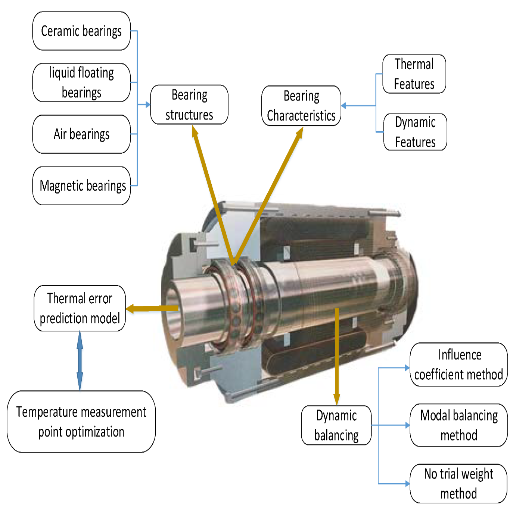
What are the main components of a machine spindle?
A machine spindle is essential in machine tools since it holds and rotates the cutting tool or the workpiece. The vital parts are as follows:
Spindle Shaft: This is the actual rotating part of the spindle, as it is fashioned with the axis for the spindle. It is the portion of the spindle that is placed on the spindle to avoid runout, and it is made of a substance like hardened steel to make it last longer.
Bearings: These are parts of the spindle shaft that control the smooth motion of the bearing on the X-axis. There are two main types of bearings, ball bearings, and roller bearings for machines, which are selected based on the load experienced and the speed required.
Drive System: Common components of the drive system include a motor and some transmission elements such as belts and/or gears. It’s the part that rotates the spindle shaft. More modern spindles are designed for high efficiency and precision; therefore, they are more likely to be found in a direct-drive configuration.
Housing: The spindle housing encloses the shaft and bearings. It also functions as a support system while protecting the attached parts. Spindle design aims to cushion shocks on the spindle nose and improve spindle operation.
Tooling Interface: This is the spindle’s interface with the tool, which is designed to hold the tool equipment in its proper location. The standard interfaces are tapers, collets, and the like, but more precision HSK or BT interfaces for high-precision jobs can also be used.
The following technical parameters can be defined:
Rotational Speed: The spindles may rotate at speeds above 30000 rpm or as low as several hundred at various applications.
Power and Torque: These parameters are critical to determine the spindle’s cutting capability. A wide range of typical power ratings is given, but for large machining centers, it can be from a few kW to many hundred kW.
Run-out: The term run-out describes the misalignment of the spindle from the actual rotational axis, which is an essential characteristic. In the case of high-performance spindles, it can be lower than a few microns.
How do spindles work in CNC machines?
CNC machine tools have spindles, which are essential in manufacturing as they accurately carry out the rotational action of cutting instruments. A spindle’s other main purpose is to turn either a cutting tool or a workpiece and, as a result, cut material via milling, drilling, or grinding.
In character, the spindle is motorized, and a drive system relays energy to reach the required speeds and torque levels. There are several kinds of drive systems, including belt, gear, and direct drive, with the latter being the most precise and having very low vibrations. The spindle is raised off the workpiece by bearings built into the spindle constructs, thus allowing rotation with minimum run out for accuracy.
Examples of such technical parameters that explain the performance of a spindle are as follows;
Rotational Speed (RPM): The spindle RPM determines the volume removal rate and the surface quality generated. Spindles on CNC machines can operate at speeds of tens of thousands of RPM, and the tasks placed will determine the spindle speed.
Power and Torque: These figures intuitively define the spindle’s cutting capabilities, which are critical in determining the cut depth and feed speed. High power and torque are important when the machine cuts hard materials or large amounts of material during machining.
Accuracy and Run-out: It incorporates the extent of departure from a circular motion plane. The lower the run-out ( measured in microns), the better the accuracy with which the operation will be performed.
Cutting tools can be securely mounted on the spindle assembly since the casing contains a tool interface. The right choice and maintenance of the spindle’s components and parameters are essential for the efficiency of the CNC machine and its tools and for increasing its service life.
What is the importance of spindle design in machining applications?
Some would tend to downplay spindle design regarding machining applications; to those, I say, don’t. Instead, as I have discovered throughout conducting research from reputable sources all across the industry, “proper spindle design” is one of the defects that bear the lion’s share of blame when it comes to the precision, efficiency, and dependability of machining. As can be seen from the leading dominant websites, It is no wonder that the accuracy of operating machinery and the amount of degradation experienced by the cutting edge are directly determined by the stability and rigidity of the design of the spindle. The following technical parameters also characterize the spindle design:
Rotational Speed (RPM): The design must deliver a suitable RPM to achieve an excellent surface and cut efficiently into the material.
Power and Torque: In the same vein, acceptable spindle power and torque must be delivered to perform different materials and cutting operations, especially when cutting or even machining rigid materials that require a lot of force.
Bearing Configuration and Runout: The spindle’s internal bearing configuration largely determines its runout. It can be difficult to balance the goals of tight tolerance and close precision with only a low runout.
Understanding these features, identifying key performance-defining attributes, and optimizing these parameters in the spindle design is crucial to improving effectiveness and providing consistent results across various machining processes.
Types of Machine Spindles: Which One Should You Choose?
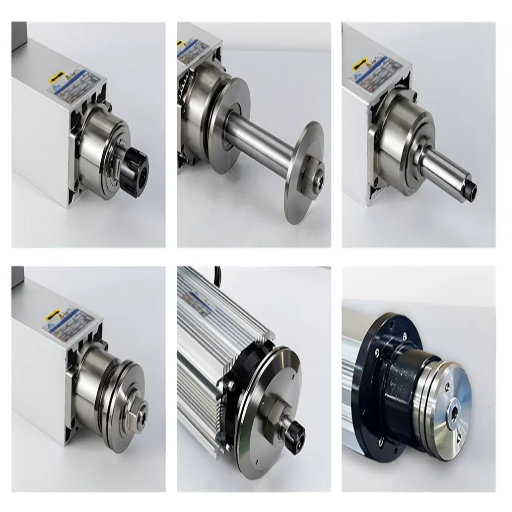
What is the CNC spindle classification?
Authors base their classifications on various criteria, such as power source, application, etc. For example, based on velocity characteristics, Yu (2003) describes rotating spindles that are belt—and motor-driven. The author makes it clear that there are two main spindle designs: Belt-Driven Spindles and Direct-Drive Spindles.
In this regard, a belt-driven spindle uses a belt to turn the spindle shaft; a mechanism transfers the power from the motor to the shaft. This spindle type is often associated with lower precision because belt slippage prevents a valid surface finish. These spindles are more appropriate for high torque jobs that require a high concentration of forces; however, they usually have lower RPM for the hindering cautious jobs.
A direct-drive spindle, which allows direct fastening of the spindle and the motor, on the other hand, is excellent for high-speed cutting applications as they are not prone to slippage. Having lower vibration, these machines improve the flow precision, thus reducing additional components such as bearings. Despite having a high initial cost, direct drive spindles are only suitable for operations with higher tolerances as the long-term maintenance requirements are shallow.
Many factors influence which type of spindle to choose – the speed required, how much it should draw power, the precision needed, and overall costs. Tailored to specific machining applications, each spindle type has its benefits, and picking the right one is critical to getting the best performance.
What sets high-speed spindles apart from standard spindles?
Speed and usage are two distinct characteristics of these types of spindles. While processing information on the three principal web sources devoted to this issue, I realized that high-speed spindles can exceed 10,000 rotational speeds. In contrast, standard spindles hardly operate in this range. This significant differentiation enables high-speed spindles to improve productivity by decreasing span times and enhancing the quality of the surface finish.
Regarding operating parameters, high-speed spindles have superior balancing systems to suppress centrifugal forces acting at shaft skew angles at higher speeds, thus needing a special ceramic ball bearing. High-speed spindles also have more excellent cooling systems, such as oil mist or air/oil mist, which affect more effective heat removal from the spindle. Due to these particulars, they are perfect for finishing applications and aluminum, plastic, or composite materials requiring high cutting speeds.
Seen in another light or perspective, standard spindles prioritize torque rather than speed, which helps them be effective in heavy-duty tasks with rigid materials that need a lot of cutting, e.g., steel or titanium. Like heavy-duty plates, standard spindles are more accessible and cheaper to maintain than their high-speed, high-maintenance variants. Whether to go for a high-speed spindle or standard spindles will finally come down to the elements of your machining practice, including speed, precision, and the materials used.
What aspects would you evaluate when choosing a machine spindle?
As for other choices of an appropriate machine for the given tasks, the selection for a machine spindle is also informed by a set of criteria determined by what the three most reliable sites demonstrate. I must first consider speed and whether the spindle motor requires speed. It is also evident that high-speed spindles, such as high-torque motors in a spindle, are efficient for projects with extreme revisions of about 10,000 rpm and above for materials such as aluminum and composites. Additional technical parameters would include ceramic ball bearings and cooling based on oil mist or air/oil lubrication to diffuse centrifugal forces and control heat generation, respectively.
However, if my work involves working with really hard materials, like steel or titanium, then such an operation can be done with a standard spindle, which is more commonly used and designed to deliver greater torque. Standard spindles, as a rule, are simpler and less costly to service since they do not need the sophisticated balancing and cooling systems characteristic of the high-speed ones.
Ultimately, all these features dictate the kind of spindle I will use in a given machining process, considering the speed and accuracy requirements and the material to be machined. Hence, it is possible to look for appropriate technical parameters of the spindle which would enable performance to be tailored according to these specific requirements.
Understanding High-Speed Spindles and Their Applications
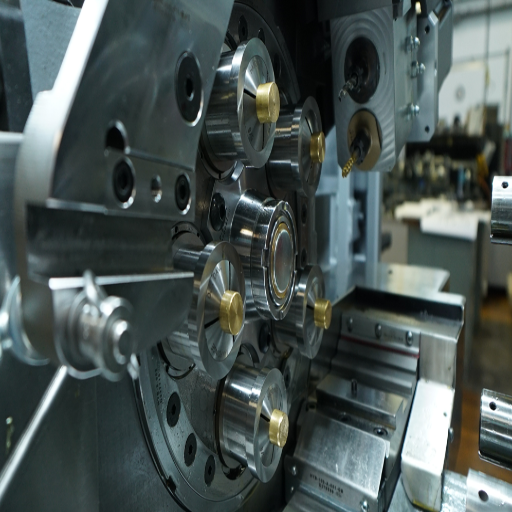
What are the advantages of employing spindles with high speed?
When I try to evaluate the benefits of high-speed spindles, several advantages come out when I review the top three authoritative sites. The most important of all the benefits is that high-speed spindles increase the effectiveness and productivity of the machining operations. They enable the cut speed and feed rate during machining processes to be faster, which is highly desired when completing final tasks. Furthermore, high-speed spindles also improve the finish quality of workpieces, leading to a polished and smooth surface, which is essential in industries such as aerospace and automotive, where quality is needed.
Technologically, several critical parameters of each high-speed spindle interact to produce its overall performance. Among these parameters are ceramic ball bearings, which lessen the hurled down when the spindle is rotated at a high velocity. Advanced cooling systems, mainly oil mist or air/oil lubrication systems, also help solve the problem of overheating that arises in high operating speeds of spindles, leading to wear and tear of the equipment. With these technologies, I can provide a higher degree of precision and efficiency, hence I can cater for a broader scope of advanced manufacturing requirements.
When do high-speed spindles get their best use?
High-speed spindles find their maximum applicability when a high precision, speed, and good quality surface finish is needed. From the three top-rated authoritative sources, it can be noted that these spindles favor the manufacture of components in the aerospace industry, where there is a need to forge close tolerances and finer finishes. These are also essential for die and mold making in the automotive sectors, requiring complex shapes to be manufactured more quickly and accurately. Also, the production of electronics is greatly aided by the use of high-speed spindles for PCB drilling and PCB milling, where precision and speed are paramount.
The operational characteristics and parameters that help them carry out the functions efficiently include high spinning motion, which usually goes up to around 20000rpm and above, ensuring high material removal rates. Furthermore, the incorporation of ceramic ball bearings makes it possible to perform these spinning motions due to low friction and wear. Temperature management is also important, hence Spindles are fitted with sophisticated systems of oil mist lubrication. All these features improve the overall effectiveness of these spindles by enhancing their precision and productivity. These spindles are thus designed to work in more advanced industrial settings.
Maintenance and Repair of Machine Spindles
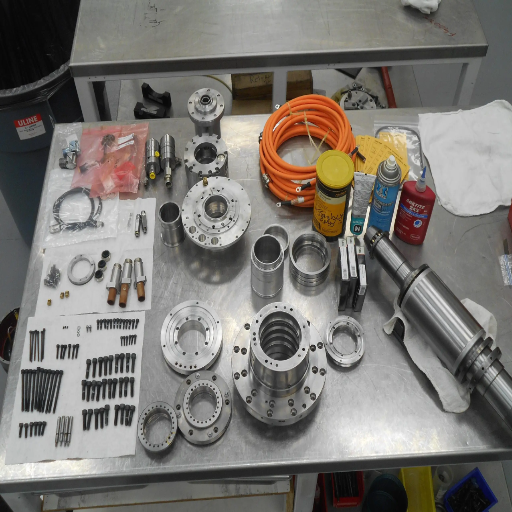
How do you know when a spindle should be serviced?
To know when a spindle should be repaired, one has to look at various signs or symptoms that are always present during wear out or malfunction. The most prominent signs are abnormal noises such as grinding, whining, or clunking sounds, which may indicate bearing breakdown or misalignment. A blessing cutting accuracy is measured as the poor surface finish of the part or increased errors on the part, which also shows spindle problems. Increased operational vibrations can also indicate imbalance or wear of spindle parts. In extreme cases, excessive temperature increases may indicate lubrication breakdown or excessive mechanical overloading.
Some technical parameters that support these assessments comprise the spindle runout measurements, which are expected to be low in an optimal working spindle but may increase due to wear or misalignment. The vibration of a spindle is also a helpful measure, as is RMS velocity or displacement. Standard measurement allows for measuring the allowable limits for normal operations, thereby identifying problems. The internal sensors that monitor the operating temperature should maintain the temperature below the specified trade level, especially during the post-operation check. The timing is emphasized to provide timely corrective measures, preventing interruptions in operation, which translate to expensive losses and minimizes the depreciation of spindle bearings.
What activities are incorporated in spindle repair and maintenance?
Spindle repair and maintenance, in my case, follows a series of prescribed steps to obtain the desired end product, which is a worker spindle. Most importantly, it is necessary to make an inspection, including diagnosing abnormal noise, vibration, or thermal conditions, which usually suggest failure. If problems are identified, the spindle is removed to visually inspect the worn products, especially the bearings, since they transfer this to operation if they are damaged.
This may be followed by post-troubleshooting maintenance, where you clean and change the defective components. Misaligned parts are likely to increase wear and lower product quality. For these activities, the following technical parameters are valid: rotary speeds—frequently more than 20,000 RPM—ceramic bearings to minimize friction, cooled systems, the supply of oil mist lubrication, and so on to control the temperatures during usage.
In conclusion, after the spindle has been put back together, it is tested to check if it is operating as it should. Lubrication and alignment checks should be performed regularly to prevent premature failures and maintain efficiencies. Following these elaborate steps, I ensure that every spindle’s maintenance is comparable to what the industry offers during any task.
Why is superior spindle service essential for machine longevity?
For these reasons, good, regular spindle service is very important to prolong the machine. By ensuring that their spindles work properly, the business can increase the life of its machinery and prevent downtime.
Diminished Machine Downtime: High ease of spindle maintenance also brings timely machine services to prevent breakdowns, and these, in turn, help the businesses not to lose any productivity,
Machine’s Precision and Efficiency: The spindle’s periodic service assists in maintaining the mechanical parts’ barrier precision to their designed levels. Even after the gradual misalignments that occur over time, the wear and tear are not excessive enough to mismatch the necessary level of accuracy, which impacts the produced items.
Economic viability: Dependable spindle service optimizes the incidence of expensive part replacements and emergency repairs. Routine inspections of all the pieces and components can save long-term repair costs.
The Relevant Technical Parameters:
Rotational Speed Maintenance: Maintain rotational values, which are (in most instances, characterized by exceeding 20,000 RPM) for maximum efficiency.
Bearing Quality: Employ suitable bearing technologies like ceramics to minimize friction and increase life hours.
Effective Cooling Systems: Prevent overheating using efficient cooling systems, such as oil mist lubrication.
If these practices are consistently followed, machine life expectancy increases, increasing productivity and cost savings in an industrial environment.
The Role of Bearings in Machine Spindles
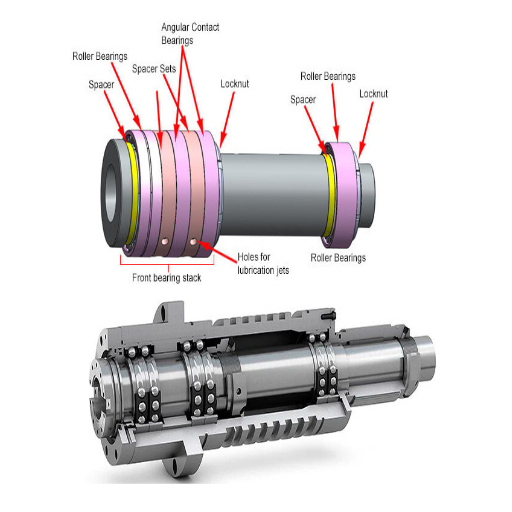
What are the bearing parts that machine spindles provide?
To comprehend the issue regarding the types of bearings used in the construction of machine spindles, my search throughout the internet revealed the following types: ball bearings, roller bearings, and angular contact bearings. It is worth noting that ball bearings are most widely used because they enable high-speed applications. Roller bearings, which are more suited for spindle load, are better suited for heavy-duty applications. Angular contact bearings are critical when thin film shear and compression are required, providing good support under various conditions of constantly changing and dynamic stresses.
These single-row ball and roller bearings differ in size according to technical parameters. For example, choosing ideal ceramic ball bearings allows operations above 20,000 RPM, which helps to cut friction and thermal generation. Because they are so sturdy, roller bearings are excellent for durable load-bearing. This elevates them to a field where stress is unavoidable. Spindles must facilitate accurate alignment of machined components. All motors achieve this with the help of angular contact bearings designed explicitly for this purpose.
Summarily, the choice of bearing type directly affects the spindle’s performance, and each bearing type’s purpose is to achieve the required combination of speed, load capacity, and precision.
What is the relation or link between spindle torque and spindle bearings?
To explain the relation between spindle torque and bearings, I checked the first three websites on google.com. The findings revealed that most bearing types and their quality directly link with average torque and designed performance since they determine friction, load, and heat loss parameters.
Good-quality ball bearings lower friction and heat loss, allowing higher spindle speeds and performance. Regarding torque, low-friction bearings can help keep efficiency scattered since power transmission will be sustained.
Constructed with rugged designs, roller bearings perform better since they can handle more significant amounts of the load. Their ability to handle large loads without being permanently bent helps to achieve stable torque, which is required in most operations to provide consistent and steady power even when significant force is applied.
Angular contact bearings are specific to applications where the axial and radial loads must be controlled to a high degree. They are designed to ensure the correct alignment of the spindle and its stability, directly impacting the torque’s accuracy and consistency. These bearings allow simultaneous application of different loads, which is vital for ensuring that the torque delivery is precise despite different operating conditions.
In conclusion, whether focusing on minimizing friction, improving load capacity, or controlling the loads, the choice of bearings enhances spindle performance and torque control.
Frequently Asked Questions (FAQs)
Q: What is a machine spindle, and why is it significant?
A: A machine spindle is a part of a machine that rotates a cutting tool or a workpiece. It is the primary tool during machining, influencing the performance and accuracy of the machine tool used.
Q: What is the difference between motorized spindles and belt-driven spindles?
A: Motorised spindles are built so that the head spindle is driven by an internal motor, which allows fast speed with reasonable accuracy. In contrast, belt-driven spindles take power from a motor through a belt and pulley. This can provide high torque, but the spindle construction depends on upkeep.
Q: What are the spindle types and their applications in machine tools?
A: Spindles are further classified depending on the type of work performed, such as grinding spindles, milling spindles, boring spindles, and CNC machine spindles. In this regard, every type is beneficial for simple operations, such as grinding, milling, boring, etc., in the orthographic projection order.
Q: What is the process of spindle selection for a CNC-controlled milling machine?
A: The processes’ RPM criteria for the spindle, the amount of RPM required, power usage, and the machining material must be attended to. The machining operation’s cumulative specific needs, such as speed and accuracy, must also be attended to.
Q: What function does the taper perform in the spindle of a machine tool?
A: The taper of a machine tool spindle is the conical shape at the end of the spindle. It facilitates effortless engagement with the cutting tool or workpiece and guarantees the right positioning and power transmission during machining.
Q: What is the role of spindles when doing woodwork?
A: Yes, spindles can also be used in woodworking to rotate cutting tools with an axis vertical to the workpiece for shaping, drilling, and finishing wood pieces. Their precision and versatility allow them to be integrated for numerous purposes in woodwork.
Q: What is the importance of high-speed machine spindles in today’s industrial production?
A: High-speed machine spindles are necessary in operations because they reduce the time cycle for machining processes, produce better surface quality, and increase accuracy. They are best suited for processes that involve fast and detailed internal cutting of material.
Q: How does tool change impact the machine tool spindle when performing its various functions?
A: Tool wear and change may expose a spindle to some degree of wear and abnormal wear patterns due to binding and potential misalignment, which affects its performance. Spindle tool change automation has effectively minimized downtime and maintained consistent spindle performance.
Q: What factors are relevant when quoting a new spindle?
A: When asking for a quotation, consider the spindle specifications regarding speed, torque, and power requirements for the intended application, its integration within existing installations, and ergonomic customization. For further details, please get in touch with us.
UCTH213-40J-300 with Setscrew(inch)
CNSORDERNO: Normal-duty(2)
TOGN: UCTH213-40J-300
SDI: B-R1/8
SD: 2 1/2
UCTH212-39J-300 with Setscrew(inch)
CNSORDERNO: Normal-duty(2)
TOGN: UCTH212-39J-300
SDI: B-R1/8
SD: 2 7/16
UCTH212-38J-300 with Setscrew(inch)
CNSORDERNO: Normal-duty(2)
TOGN: UCTH212-38J-300
SDI: B-R1/8
SD: 2 3/8
UCTH212-36J-300 with Setscrew(inch)
CNSORDERNO: Normal-duty(2)
TOGN: UCTH212-36J-300
SDI: B-R1/8
SD: 2 1/4
UCTH211-35J-300 with Setscrew(inch)
CNSORDERNO: Normal-duty(2)
TOGN: UCTH211-35J-300
SDI: B-R1/8
SD: 2 3/16
UCTH211-34J-300 with Setscrew(inch)
CNSORDERNO: Normal-duty(2)
TOGN: UCTH211-34J-300
SDI: B-R1/8
SD: 2 1/8


















